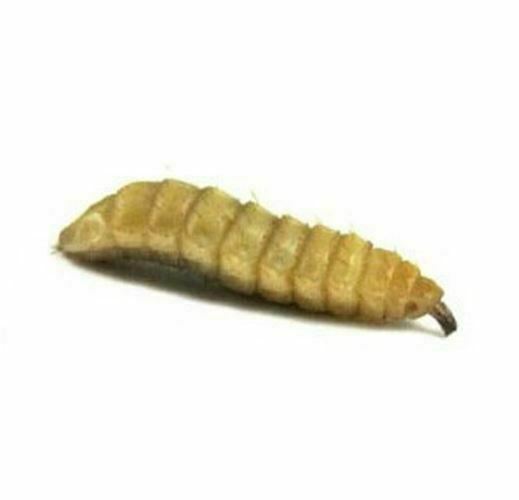 |
| Printable: Fluker's Soldier Worms Care Guide (PDF) |
Download |
| Video Tutorials: Fluker's Feeder Insect Care Tutorials (YouTube) |
Watch Now |
Introduction
Common name: Black Soldier Fly
Scientific name: Hermetiaillucens
Black Soldier Fly Larvae (BSFL), the larval stage of the black soldier fly (Hermetiaillucens), are increasingly popular as feeder insects for reptiles due to their excellent nutritional profile. BSFL are naturally high in calcium and phosphorus, making them an excellent choice for reptiles that require calcium-rich diets, such as bearded dragons and geckos. They also have a softer exoskeleton compared to other feeder insects, making them easier for your pets to digest.
Nutritional Benefits
BSFL are highly valued for their balanced nutrient content, especially their high and balanced calcium-to-phosphorus ratio. This eliminates the need for dusting them with calcium supplements, which is often required for other feeder insects. They also contain natural antimicrobial properties that may help boost your pet’s immunity.
Typical nutritional analysis of black soldier fly larvae:
-
Moisture: 73.2%
-
Protein: 57%
-
Calcium: 3.14%
- Phosphorus: 1.28%
Unique Characteristics
-
High Calcium Content: BSFL have one of the highest natural calcium levels among feeder insects, making them ideal for reptiles that require a calcium-rich diet.
-
Soft Exoskeleton: Their softer exoskeleton makes them easier to digest, reducing the risk of impaction in reptiles.
-
Sustainability: BSFL are environmentally sustainable, as they can be fed on food waste, contributing to waste reduction.
Housing and Bedding
-
Container: Use a ventilated plastic container or any container with smooth sides and small air holes. BSFL can climb, so ensure the lid fits securely.
-
Substrate: No specific substrate is required, but you can use coconut coir, peat moss, or moistened wheat bran as bedding. However, BSFL will thrive on the organic material they are fed.
Feeding and Maintenance
-
Temperature: BSFL thrive in temperatures between 70-85°F (21-29°C). To prevent them from pupating keep them at cooler temperatures.
-
Moisture and Food: BSFL do not require additional moisture. They are typically shipped with enough food to sustain them, but you can add small amounts of food waste (like fruits, vegetables, or grains) if you plan to keep them long-term.
-
Cleaning: BSFL do not produce much waste, so cleaning is minimal. If needed, remove any uneaten food and replace it with fresh scraps to prevent mold growth.
Storage
-
Short-term Storage: Keep BSFL at room temperature if you plan to use them quickly.
-
Long-term Storage: For longer storage, keep them at cooler temperatures (50-55°F or 10-13°C) to slow their development and prevent them from pupating. Do not refrigerate them at temperatures below 50°F, as this can kill them. When cooled down BSFL will become much less active. They will consume much less food as well as a result will not grow.
-
When preparing to feed, remove BSFL 24 hours prior to feeding to allow them time to gut load and become more active for your pet.
Feeding to Reptiles
-
Gut-loading: BSFL are naturally nutritious and high in calcium, so additional gut-loading is not necessary. But they can be given small amounts of fruits and vegetables.
-
No Dusting Required: Due to their high calcium content, BSFL do not need to be dusted with calcium supplements before feeding.
-
Feeding Frequency: Feed BSFL directly to your reptiles, adjusting the quantity based on the size and dietary needs of your pet. If stored in cooler temperatures make sure to place your larvae in room temperature to allow time for them to become more active.
Additional Considerations
- Lifespan: BSFL remain in their larval stage for several weeks at cool temperatures. After that, they will begin to pupate. Once they reach the pupae stage, they are no longer suitable as feeder insects, so it’s best to use them while they are still larvae.
- Composting: BSFL can also be used for composting organic waste, making them a dual-purpose addition to your home.
-
Disposal: To dispose of live feeders responsibly, place in an escape-proof bag or container, freeze for at least 24 hours, and then dispose of in the garbage can. Never release live feeders into the wild as they can be harmful to the native environment!


